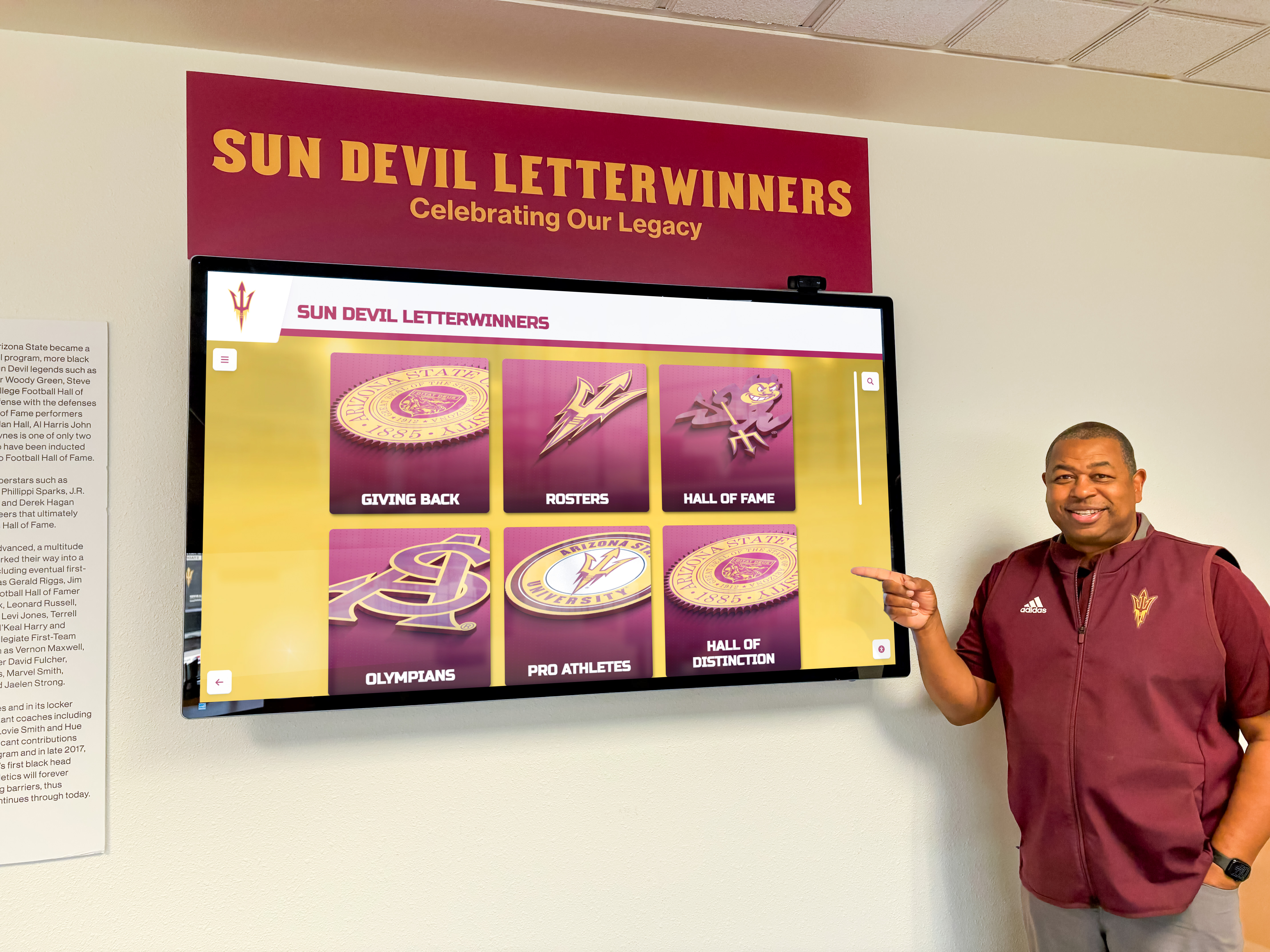College athletics programs build institutional pride, forge lasting memories, and create traditions that connect generations of students, athletes, alumni, and fans. A college athletics hall of fame serves as the cornerstone for preserving these achievements, honoring exceptional student-athletes who excelled in their sports, and celebrating the coaches, administrators, and supporters who built programs of excellence. From Division I powerhouses to Division III liberal arts colleges, athletic halls of fame create tangible connections between past achievement and future aspiration.
As universities embrace digital transformation across academic and administrative functions, athletic departments discover that modern recognition systems offer compelling advantages for celebrating sports excellence. Digital hall of fame displays accommodate unlimited inductees across all sports, enable rich multimedia storytelling impossible with traditional plaques, and create engaging experiences that inspire current student-athletes while honoring those who came before.
The Significance of College Athletics Hall of Fame Programs
College athletics hall of fame programs serve multiple critical purposes beyond simple recognition. They preserve institutional athletic history across all sports, connect current teams to program traditions and legacies, inspire student-athletes to pursue excellence both on the field and in the classroom, engage alumni communities around shared athletic experiences, and demonstrate the university's commitment to honoring comprehensive achievement. Digital recognition solutions like Rocket Alumni Solutions enable athletic departments to create professional, engaging displays that celebrate athletic legends appropriately while remaining easily updatable as new inductees join the hall of fame each year.
Why Colleges Need Comprehensive Athletics Halls of Fame
College athletic programs at all competitive levels—from major conference universities to small college programs—benefit significantly from formal hall of fame recognition systems that honor distinguished contributors across all sports, not just the highest-profile programs.
Preserving Multi-Sport Athletic History
Institutional athletic memory naturally fades as coaches retire, administrators move on, record books are lost, and decades pass without systematic documentation. Hall of fame programs create permanent records of achievement that ensure legendary athletes, championship teams, and transformational coaches across all sports remain part of collective memory rather than being gradually forgotten.

Historical Documentation Across All Sports: Comprehensive hall of fame displays create permanent records of program milestones—conference championships, national tournament appearances, All-American selections, coaching tenures, and statistical records across sports ranging from football and basketball to track and field, swimming, soccer, tennis, and beyond. This systematic documentation preserves details that might otherwise exist only in deteriorating newspaper clippings, forgotten yearbooks, or fading memories of aging alumni.
Cultural Continuity for All Programs: When current student-athletes understand program history across all sports—learning about legendary teams, record-setters who came before, and traditions they inherit—they develop deeper connections to comprehensive athletic programs. This historical consciousness creates responsibility for maintaining excellence while demonstrating that the institution values achievement in all athletic endeavors, not just revenue sports.
Tradition Reinforcement Across Athletic Department: Hall of fame recognition reinforces program traditions, values, and identity elements that distinguish institutions. Whether celebrating sportsmanship, academic excellence alongside athletic achievement, or community engagement, recognition systems communicate what athletic programs stand for beyond winning percentages and conference standings.
Resources on comprehensive sports recognition solutions demonstrate how modern systems preserve not just names and statistics but the full context and narratives that make athletic program history meaningful across all sports.
Inspiring Current Student-Athletes Across All Sports
Recognition of past excellence creates powerful motivation for current athletes across all programs who see tangible evidence of what commitment, dedication, and achievement can accomplish:
Visible Achievement Pathways: When student-athletes see detailed profiles of hall of fame inductees from their specific sports—learning about their journeys from recruits through college careers to post-graduation success—they understand concrete pathways to excellence. These examples make ambitious goals feel attainable while demonstrating that the institution honors achievement across all athletic programs equally.
Record Chase Motivation: Displaying all-time program records across sports alongside current season leaders shows athletes exactly what achievements remain within reach. This visibility creates motivation for pursuing records while generating community excitement about potential milestone performances in sports ranging from swimming to cross country to volleyball.
Values Reinforcement: Hall of fame recognition highlighting not just athletic statistics but also academic achievements, leadership qualities, and community contributions reinforces comprehensive program values. Student-athletes see that complete excellence—not just on-field performance—earns lasting recognition regardless of sport or profile level.
Connection to Legacy: Understanding that exceptional performance and character across any sport can result in permanent recognition creates powerful motivation. The possibility of joining program legends in the hall of fame inspires sustained commitment and excellence-driven behavior among student-athletes competing in all programs.

Strengthening Alumni Engagement Across Sports
Hall of fame programs create natural connection points between universities and former student-athletes across all sports, fostering engagement that extends well beyond playing careers:
Ongoing Recognition for All Sports: Alumni whose playing careers ended decades ago in sports ranging from tennis to track maintain connections to programs that continue recognizing their achievements. Hall of fame induction or display features create opportunities for universities to re-engage former athletes from all sports and celebrate their continued contributions to institutions and communities.
Reunion Catalysts: Hall of fame induction ceremonies provide natural occasions for team reunions across multiple sports, creating opportunities for former teammates to reconnect while current athletes benefit from interactions with alumni who embody traditions and values spanning diverse athletic programs.
Mentorship Opportunities: Honored alumni from all sports often become willing mentors for current athletes, sharing experiences, providing career guidance, and offering networking connections. Hall of fame recognition creates frameworks for formalizing these valuable mentorship relationships that benefit student-athletes competing in all programs.
Fundraising Connections: Alumni with strong emotional connections to athletic programs—strengthened through hall of fame recognition—represent prime prospects for athletic giving. Recognition demonstrates institutional appreciation for contributions across all sports while creating contexts for soliciting support that benefits entire athletic departments.
Resources on alumni engagement through interactive recognition displays provide strategies for leveraging recognition systems to build lasting relationships with former student-athletes across all sports.
Demonstrating Institutional Commitment to All Programs
Comprehensive recognition programs that honor achievement across all sports—not just football and basketball—communicate powerful messages about institutional values and commitment to complete athletic programs:
Equity Across Sports: Hall of fame programs that celebrate excellence in Olympic sports, emerging sports, and non-revenue programs alongside traditional revenue sports demonstrate genuine institutional commitment to comprehensive athletics. This equity matters to recruits, current athletes, and alumni from all programs who want to know their achievements will be valued equally.
Academic and Athletic Balance: Recognition highlighting academic achievements, graduation rates, and post-college success alongside athletic accomplishments demonstrates that athletic programs serve broader educational missions. This comprehensive recognition appeals to prospective students and their families seeking programs that develop complete individuals, not just athletes.
Long-Term Program Building: Systematic recognition documenting decades of achievement across all sports provides tangible evidence of sustained institutional commitment to comprehensive athletics rather than just recent success in high-profile programs. This historical perspective demonstrates stability and commitment that influences recruit decisions.
Categories for College Athletics Hall of Fame Recognition
Comprehensive hall of fame programs recognize diverse contributions to athletic program success across multiple sports and roles beyond just exceptional athletes. Well-designed recognition systems celebrate multiple excellence pathways while maintaining meaningful standards.
Student-Athlete Inductees Across All Sports
Individual athletes who demonstrated exceptional performance, leadership, and character during college careers across all sports represent the core of most hall of fame programs:
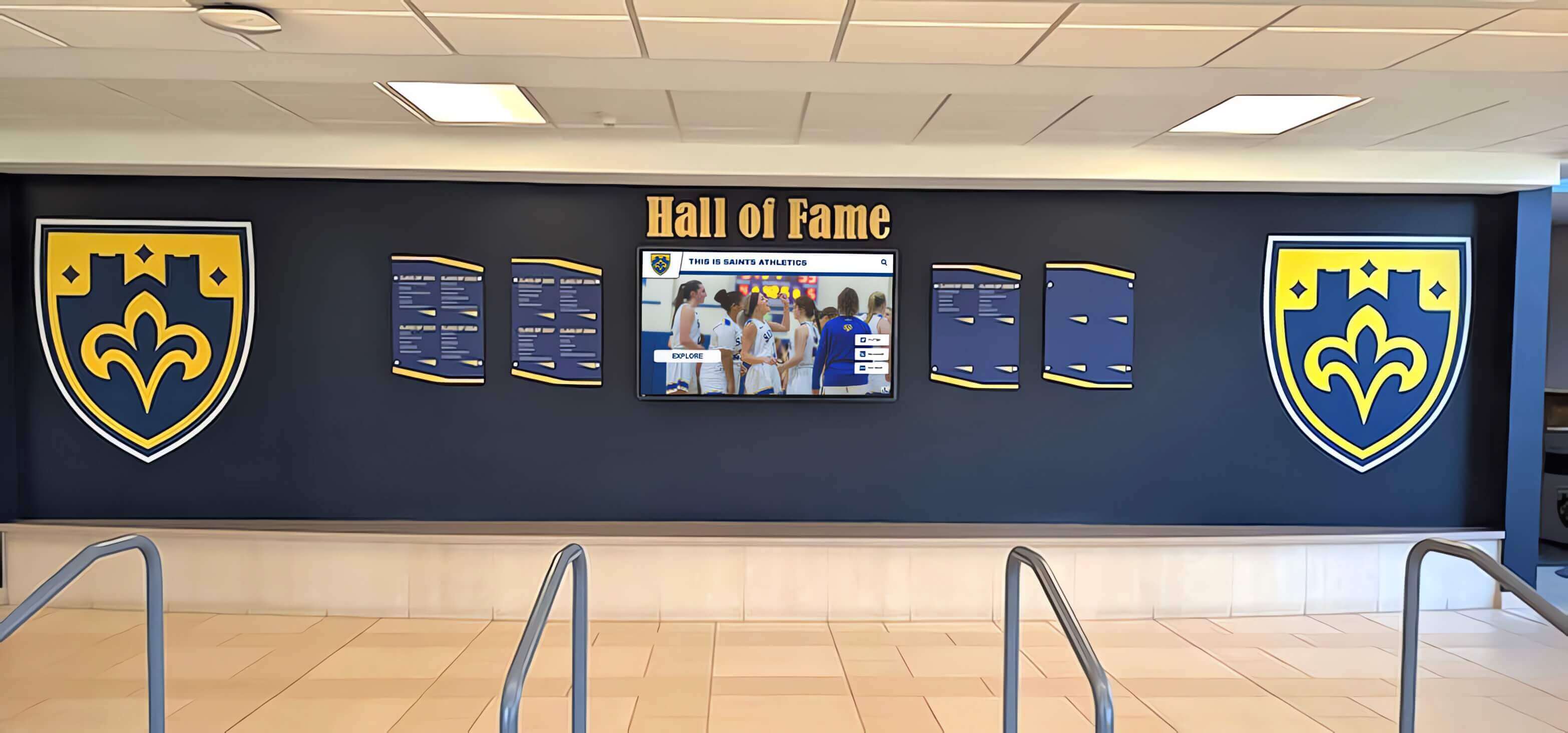
All-Americans and National Award Winners: Athletes earning All-American honors, conference player of year awards, or national recognition represent obvious hall of fame candidates whose achievements achieved national prominence. This category should include All-Americans from all sports—swimming, wrestling, track and field, volleyball, soccer—not just football and basketball.
Conference Champions and Statistical Leaders: Athletes who won conference championships, set program records, or dominated conference statistical categories across their sports demonstrated sustained excellence deserving recognition. Conference recognition often represents the highest achievement level for student-athletes competing outside major revenue sports.
Multi-Sport Athletes: Student-athletes who excelled in multiple sports simultaneously—competing in both fall and spring sports, or balancing academic demands while lettering in two or three sports—demonstrated exceptional versatility and commitment worthy of special recognition.
Academic All-Americans: Athletes who combined athletic excellence with academic distinction—earning Academic All-American recognition or similar honors—exemplify the student-athlete ideal and deserve recognition highlighting their comprehensive achievement across classroom and competition.
Professional Success: Alumni who achieved professional athletic careers—competing in professional leagues, Olympics, or international competitions—bring reflected glory to college programs and merit hall of fame recognition that celebrates how college experience prepared them for continued excellence.
Coaching Inductees Across All Sports
Coaches who built programs, developed talent, and created winning traditions deserve recognition alongside the athletes they mentored, with hall of fame programs honoring coaches from all sports, not just high-profile programs:
Championship Coaches in All Sports: Head coaches who led teams to conference championships, national tournament appearances, or national titles across any sport achieved the ultimate measure of coaching success and clearly merit hall of fame inclusion. Championships in Olympic sports, emerging sports, and non-revenue programs deserve equal recognition to traditional revenue sport championships.
Program Builders: Coaches who elevated programs to new competitive levels—increasing win totals, achieving program-first milestones, establishing sustained excellence in developing sports—leave lasting legacies deserving permanent recognition. Coaches who built volleyball programs, established swimming traditions, or developed track and field excellence merit recognition equal to football or basketball program builders.
Coaching Longevity Across Programs: Long-tenured coaches who dedicated significant portions of careers to single institutions demonstrate loyalty and commitment worthy of appreciation. Assistant coaches, coordinators, and position coaches across all sports who mentored athletes and contributed to program excellence deserve consideration alongside head coaches.
Developer of Talent: Coaches recognized for exceptional ability to develop talent—transforming unranked recruits into All-Conference performers, preparing student-athletes for professional opportunities, or maximizing athlete potential across ability levels—demonstrate coaching excellence worthy of recognition.
Resources on teacher appreciation and recognition provide frameworks applicable to honoring coaches who shaped student-athlete lives beyond athletic performance across all sports.
Team Inductees Across All Sports
Championship and historically significant teams merit collective recognition that honors shared achievement and team chemistry across all sports:
Conference and National Champions: Conference championship teams, national tournament qualifiers, and national championship teams achieved collective excellence deserving permanent commemoration regardless of sport. Championship volleyball teams, swimming and diving squads, soccer programs, and track teams deserve recognition equal to revenue sport champions.
Undefeated Seasons: Teams completing undefeated regular seasons or achieving perfect conference records achieved rare collective excellence worth celebrating. Perfect records represent remarkable team achievements across any sport deserving recognition.
Historic Milestone Teams: Teams achieving program firsts—first conference title in a sport, first national tournament appearance, first victory over traditional rival—hold special significance in program history and deserve recognition for breakthrough achievements regardless of sport profile.
Record-Setting Teams: Teams establishing program or conference records for winning streaks, points scored, defensive dominance, or other measurable collective achievements demonstrated systematic excellence across entire rosters worthy of commemoration.

Contributor Inductees
Non-playing contributors whose support, advocacy, or service significantly impacted athletic programs deserve recognition alongside athletes and coaches:
Athletic Directors and Administrators: Administrators who built facilities, increased resources, elevated programs competitively, added new sports, or demonstrated sustained commitment to comprehensive athletic excellence contributed indirectly but significantly to program success across all sports.
Athletic Trainers and Medical Staff: Long-serving athletic trainers, team physicians, sports psychologists, and medical professionals who kept student-athletes healthy and enabled sustained performance across all sports deserve appreciation for essential but often under-recognized contributions.
Support Staff: Strength coaches, academic advisors, equipment managers, and operations staff who dedicated careers to supporting athletic program success across all sports enable achievement and merit recognition for sustained service.
Boosters and Donors: Major financial supporters whose philanthropy built facilities, endowed scholarships, funded new sport additions, or provided resources enabling athletic program excellence made tangible contributions deserving acknowledgment.
Selection Criteria and Nomination Processes
Credible hall of fame programs require transparent selection criteria and structured nomination processes ensuring fair, defensible decisions that maintain recognition standards and community respect.
Establishing Clear Eligibility Requirements
Specific eligibility standards prevent confusion and establish baseline requirements for hall of fame consideration across all sports:
Waiting Periods: Most programs require minimum waiting periods—commonly five to ten years—between completing college eligibility and hall of fame eligibility. This ensures perspective on careers and achievements while allowing post-college accomplishments to inform decisions. Waiting periods should be consistent across all sports.
Participation Requirements: Eligibility typically requires completing college eligibility at the institution, preventing transfer athletes who played minimally from consideration while recognizing those who invested full careers in programs. Some programs make exceptions for athletes who competed multiple years before transferring for graduate programs or other legitimate reasons.
Character Standards: Many programs require exemplary conduct and character, reserving hall of fame honor for individuals whose behavior and values align with institutional standards. This prevents recognition of athletes whose post-college actions would embarrass institutions regardless of their athletic accomplishments.
Achievement Thresholds: While specific criteria vary by sport and program, institutions typically establish achievement thresholds—All-Conference honors, statistical benchmarks, championship participation, or comparable standards—ensuring recognition maintains meaningful standards. Thresholds should be sport-appropriate, recognizing that achievement measures differ between football, swimming, track and field, and golf.
Creating Nomination Processes
Structured nomination systems balance accessibility with thoroughness while documenting decision rationales:
Open Nomination Windows: Annual nomination periods—typically several months—allow adequate time for supporters to prepare thorough nominations while creating regular recognition opportunities. Open processes ensure worthy candidates from all sports receive consideration rather than relying solely on committee knowledge.
Nomination Form Requirements: Standardized forms requesting specific information—biographical details, achievement summaries, supporting documentation, statistical records, reference contacts—ensure consistent information for evaluation while requiring nominators to document cases thoroughly. Forms should accommodate sport-specific achievement measures.
Multiple Nomination Sources: Accepting nominations from various sources—alumni, current coaches, athletic staff, fans, fellow athletes—ensures worthy candidates from all sports receive consideration regardless of personal connections to current decision-makers.
Automatic Considerations: Some programs automatically consider individuals meeting certain thresholds—All-Americans, conference champions, statistical record holders—ensuring obvious candidates receive evaluation even without formal nominations. Automatic consideration helps ensure athletes from lower-profile sports receive fair evaluation.
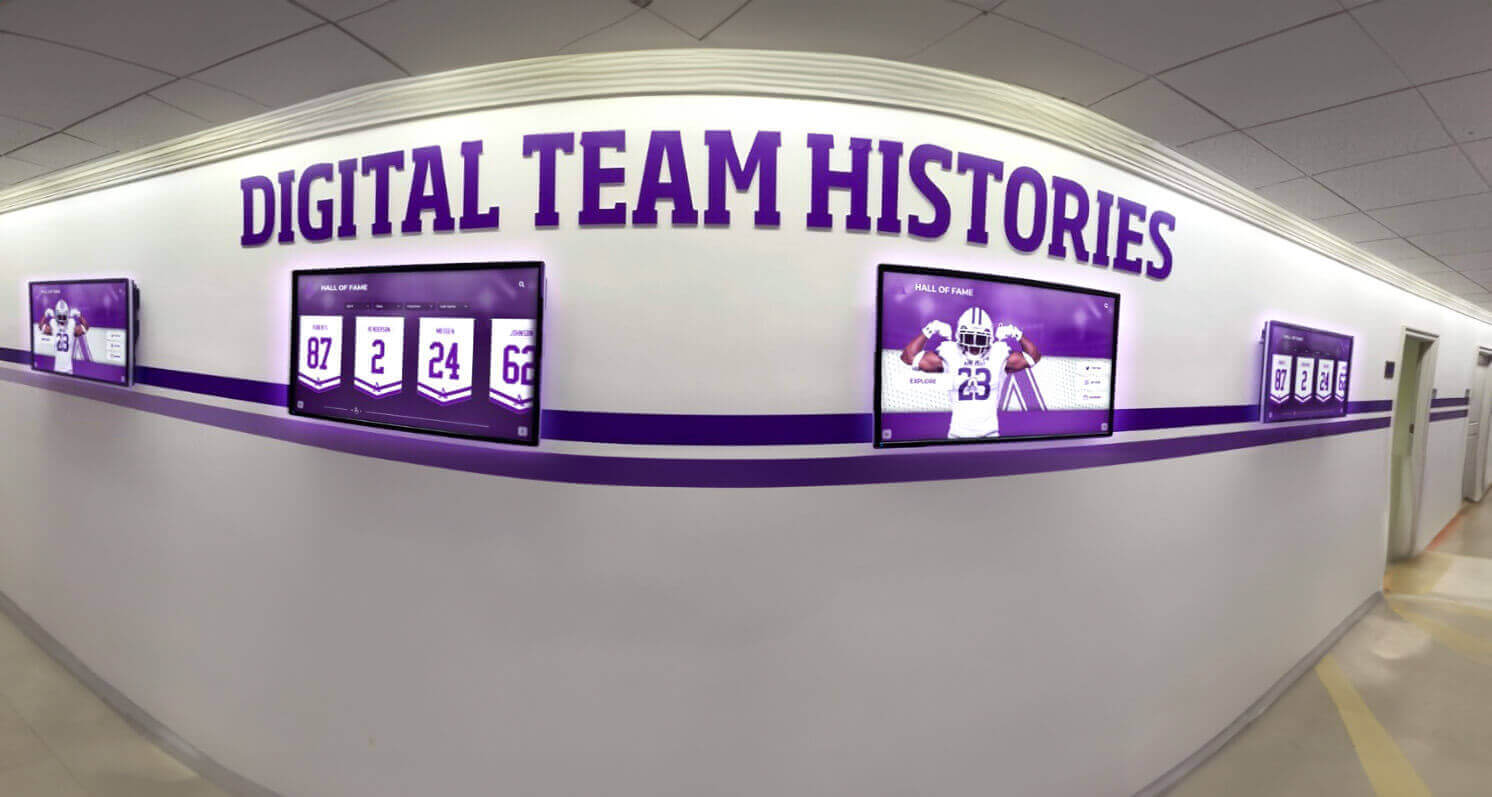
Selection Committee Structure
Committee composition should ensure diverse perspectives, sport-specific knowledge, and credibility:
Membership Diversity: Committees should include athletic administrators, former athletes from multiple sports, former coaches across programs, faculty representatives, and community members. Diverse composition prevents single-sport domination while bringing varied expertise and ensuring all athletic programs receive fair consideration.
Sport-Specific Expertise: Committees benefit from members with knowledge across multiple sports who understand achievement contexts in Olympic sports, team sports, and individual sports. Without sport-specific knowledge, committees risk undervaluing achievements in less familiar sports or applying inappropriate comparison standards.
Rotating Terms: Staggered, limited terms bring fresh perspectives while maintaining continuity. This prevents committees from becoming stagnant or dominated by particular viewpoints while ensuring institutional knowledge persists through member transitions.
Conflict Management: Clear policies addressing committee member relationships with nominees—requiring recusals when appropriate—maintain selection integrity and prevent appearance of favoritism or sport-specific bias.
Resources on digital hall of fame planning help athletic departments develop structured selection processes that ensure fair evaluation across all sports.
Modern Display Options for College Athletics Hall of Fame Programs
Athletic departments implementing or upgrading hall of fame recognition face important decisions about display formats, with options ranging from traditional physical displays to cutting-edge interactive systems that can showcase achievements across all sports effectively.
Traditional Physical Recognition
Conventional recognition formats remain popular for their tangible presence and formal aesthetic:
Engraved Plaques and Nameplates: Individual plaques mounted in hallways, athletic facilities, or lobbies provide permanent, formal recognition. While limited in information capacity, plaques convey gravitas and permanence that resonates with traditional audiences. However, physical space constraints often force difficult decisions about which sports receive prominent placement.
Trophy Cases and Displays: Glass-enclosed cases displaying jerseys, equipment, awards, and commemorative items create three-dimensional recognition with artifact authenticity. Trophy cases work particularly well for championship recognition but face capacity constraints when trying to honor achievements across all sports equally.
Photo Walls and Boards: Mounted photographs with name plates provide visual recognition allowing viewers to see inductees. Photo displays create personal connections but face challenges with consistency across eras, space limitations that favor certain sports, and maintenance requirements.
Limitations of Physical Displays: Traditional formats share common constraints—limited information capacity forcing selectivity, difficulty updating across all sports, space restrictions preventing unlimited growth, inability to showcase achievements from lower-profile sports equally, and inability to incorporate multimedia elements that bring diverse athletic achievements to life.
Digital Recognition Systems
Interactive digital displays overcome traditional format limitations while offering expanded capabilities for comprehensive multi-sport recognition:
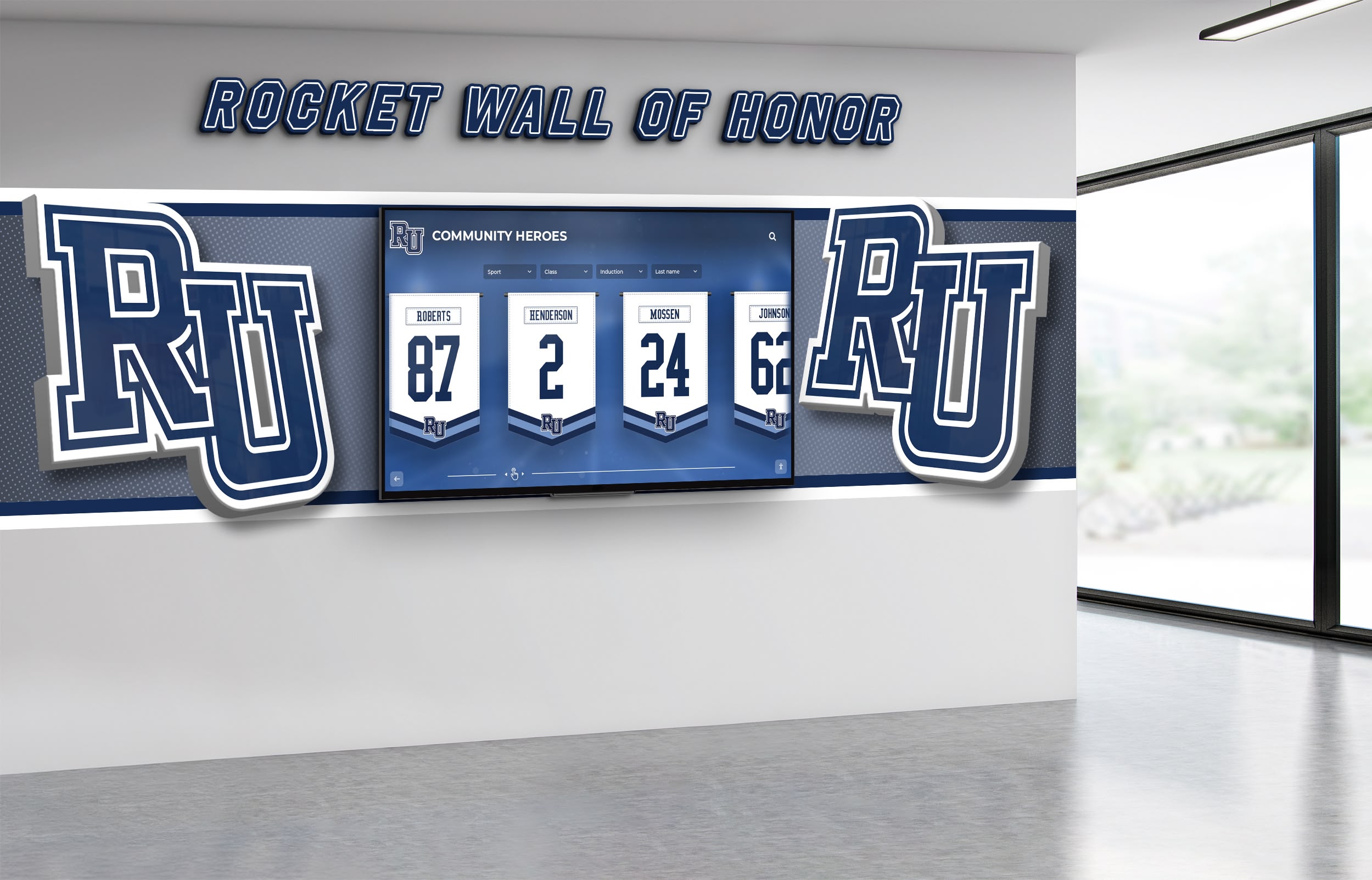
Touchscreen Hall of Fame Kiosks: Interactive touchscreens allow visitors to explore detailed inductee profiles across all sports, search by name or sport, filter by achievement type or era, and access multimedia content including video highlights, audio interviews, and extensive photo galleries. Solutions like interactive hall of fame systems provide intuitive interfaces encouraging extended engagement while ensuring equal representation for all sports.
Video Display Walls: Large-format digital signage cycles through inductee recognition, championship highlights, and program history content across all sports. Video walls create dramatic visual impact in high-traffic areas while accommodating unlimited content rotation that ensures all programs receive visibility.
Web-Based Virtual Halls of Fame: Online hall of fame platforms extend recognition beyond physical locations, allowing alumni worldwide to explore athletic program history across all sports. Web-based systems complement physical displays while providing searchable databases accessible anywhere that ensure achievements in all sports remain visible.
Mobile-Integrated Displays: Systems with companion mobile apps or QR code access enable visitors to explore content on personal devices, continue engagement beyond athletic facilities, and share content via social media. Mobile integration extends recognition reach while allowing deep dives into specific sports or athletes.
Resources on platforms for building virtual halls of fame help athletic departments evaluate digital options and select solutions matching their needs for comprehensive multi-sport recognition.
Advantages of Digital Hall of Fame Displays
Interactive digital systems offer compelling benefits for comprehensive athletic department recognition programs:
Unlimited Capacity Across All Sports: Digital displays accommodate hundreds of inductees from all sports without space constraints. As programs grow, adding inductees from swimming, soccer, tennis, track, and other programs requires content updates rather than physical construction or difficult decisions about which sports receive limited display space.
Equitable Multi-Sport Representation: Digital systems enable equal showcase opportunities for achievements across all sports. Olympic sport athletes, individual sport competitors, and team sport participants receive identical profile formats, eliminating the visibility advantages traditional displays often give to football and basketball.
Rich Multimedia Content: Video highlights, audio interviews, photo galleries, career statistics, and extensive narratives create comprehensive profiles impossible with physical plaques. Multimedia storytelling brings achievements to life emotionally while accommodating sport-specific content needs—swim meet footage, track race videos, volleyball match highlights, tennis tournament results.
Easy Updates and Maintenance: Adding inductees from any sport, correcting information, or enhancing profiles requires simple content management rather than ordering new plaques or physically modifying displays. This ease reduces long-term costs and maintenance burdens while ensuring all sports receive timely recognition.
Search and Filtering Capabilities: Visitors can instantly locate specific athletes, explore inductees from particular sports, filter by achievement category, or browse by era. This functionality enhances user experience while ensuring achievements from all sports remain discoverable rather than being hidden in crowded physical displays.
Analytics and Engagement Data: Digital systems track which inductees generate most interest, which sports receive most views, and engagement patterns. These insights inform content development while demonstrating recognition program value across all athletic programs to administrators.
Guidance on selecting touchscreen kiosk software helps athletic departments navigate technical decisions and choose platforms supporting comprehensive multi-sport recognition needs.
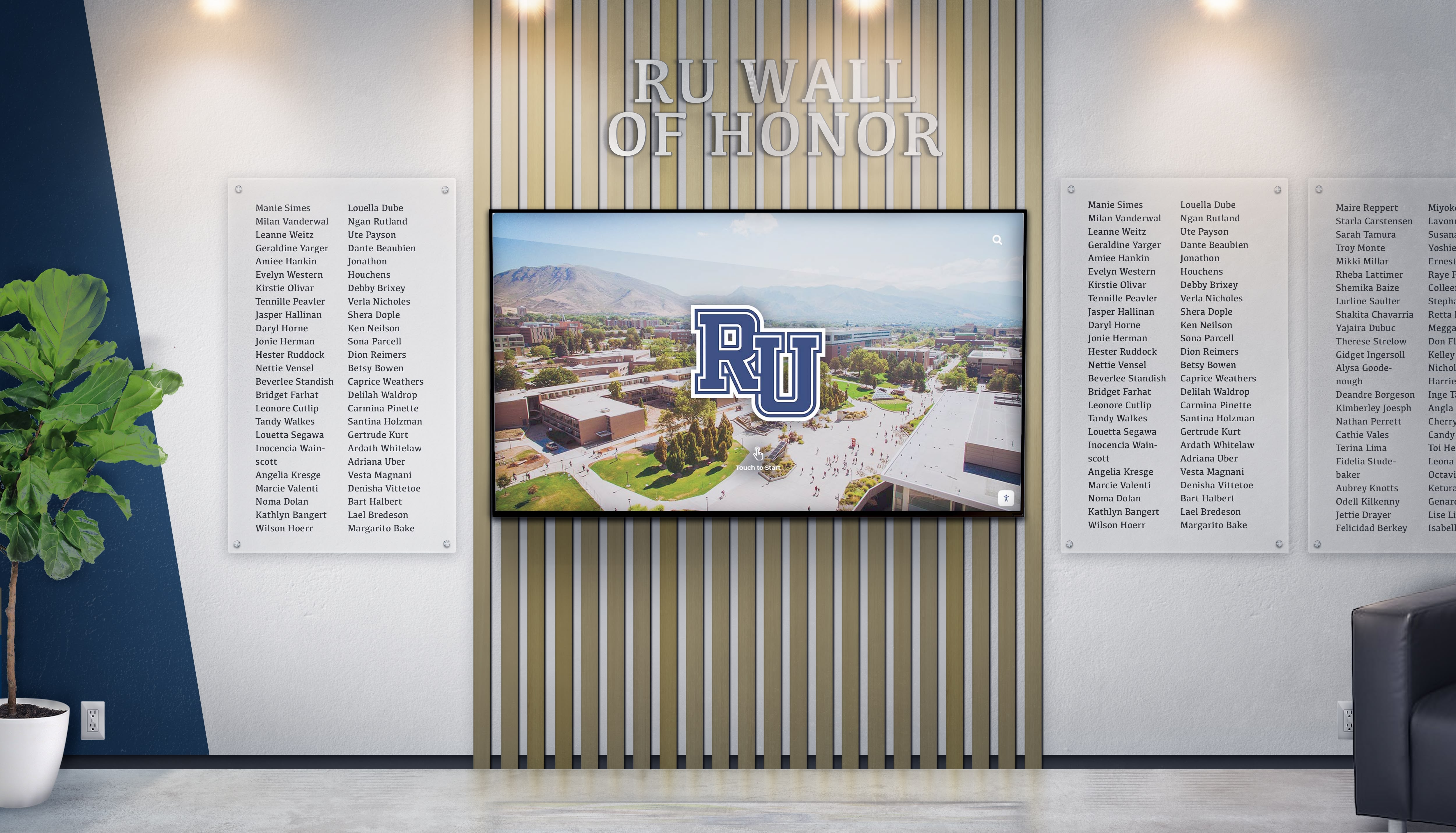
Hybrid Recognition Approaches
Combined physical and digital recognition offers advantages of both formats while addressing diverse stakeholder preferences:
Many programs successfully blend traditional recognition—maintaining some physical plaques or trophy cases for their tangible gravitas and tradition—with digital displays providing expanded content, comprehensive multi-sport coverage, search capabilities, and unlimited capacity. This hybrid approach satisfies traditional preferences while embracing modern capabilities that ensure equitable recognition across all athletic programs.
Content Development for Comprehensive Athletic Recognition
Effective recognition requires compelling content that honors inductees appropriately across all sports while engaging audiences and telling complete achievement stories.
Essential Profile Elements for All Sports
Comprehensive inductee profiles should include standard information elements ensuring consistent, thorough recognition regardless of sport:
Biographical Information: Full name, years attended, hometown, sport competed, position or events, and current location provide basic context. Including jersey numbers or other sport-specific identifiers creates additional recognition elements particularly meaningful to fellow athletes and fans.
Athletic Achievements: Detailed summary of competitive accomplishments—statistical achievements, honors received, memorable performances, championship participation, and record-setting achievements. Specific, quantifiable details prove more compelling than general praise and should be presented in sport-appropriate contexts.
Academic Recognition: Honors such as Academic All-Conference, Scholar-Athlete awards, or graduation distinctions demonstrate comprehensive excellence beyond athletics. Academic achievements resonate with university values and provide holistic recognition that applies to athletes across all sports.
Post-College Success: Professional athletic careers, career achievements in other fields, community leadership roles, and continued contributions to university or society demonstrate long-term impact of college experiences. Post-college success validates university investment in student-athlete development across all programs.
Personal Reflections: First-person quotes about college experiences, teammates remembered, coaches who influenced them, and advice for current athletes create personal connections and convey program values. Personal narratives humanize achievements beyond statistics regardless of sport.
Multimedia Elements: Action photographs, highlight video clips, audio interviews, newspaper clippings, and other visual content bring profiles to life beyond text alone. Rich multimedia creates emotional engagement traditional formats cannot match while accommodating sport-specific content needs.
Resources on storytelling through digital recognition provide detailed strategies for creating compelling narratives that honor achievements across all sports while engaging diverse audiences.
Writing Compelling Recognition Content
Professional content development requires attention to tone, accuracy, and engagement across diverse sports:
Sport-Appropriate Language: Use terminology and metrics appropriate to each sport. Swimming profiles discuss times and relay performances, track profiles highlight personal records and event specializations, volleyball content focuses on kills and defensive statistics, wrestling profiles detail weight classes and tournament placements.
Active, Engaging Language: Write in active voice using dynamic verbs and specific details. “Johnson recorded 327 kills while leading the volleyball team to the conference championship” engages readers more effectively than “Johnson was a good volleyball player.”
Specific Achievement Details: Quantify accomplishments whenever possible using sport-appropriate metrics. Instead of “outstanding track athlete,” write “competed in three NCAA championships, earning All-American honors in the 800 meters with a personal best of 1:48.23.”
Historical Context: Provide context helping audiences understand achievement significance within sport-specific frameworks. Note where statistics rank in program history, explain competitive landscape during competition era, or describe obstacles overcome specific to the sport.
Balanced Tone: Maintain professional, respectful tone avoiding hyperbole or flowery language. Let achievements speak for themselves through specific details rather than excessive adjectives, ensuring equity in recognition quality across all sports.

Ensuring Equitable Coverage Across All Sports
Comprehensive programs require deliberate attention to equitable representation:
Equal Profile Quality: Ensure inductee profiles from Olympic sports, individual sports, and emerging sports receive the same depth, multimedia content, and professional presentation as football and basketball profiles. Equity in profile quality demonstrates genuine institutional commitment to all programs.
Balanced Historical Representation: When developing historical content, ensure proportional representation across all sports that existed during various eras. Don’t allow easier availability of football and basketball records to result in those sports dominating historical recognition.
Sport-Specific Achievements: Recognize achievements meaningful within specific sports even if they lack equivalent recognition in other programs. Conference championships matter equally whether in soccer or football, All-Conference honors deserve equal recognition whether in swimming or basketball, and program records merit celebration across all sports.
Ongoing Content Enhancement: As technology capabilities grow or additional content becomes available, enhance existing profiles across all sports proportionally rather than focusing enhancements on high-profile programs.
Implementation Best Practices for College Athletics Recognition
Athletic departments launching or upgrading comprehensive hall of fame programs should follow proven practices ensuring successful implementation and long-term sustainability across all sports.
Planning Phase Considerations
Thorough preparation establishes foundations for program success:
Goal Definition: Clearly articulate program purposes—preserving history across all sports, inspiring current athletes in all programs, engaging diverse alumni communities, demonstrating institutional commitment to comprehensive athletics. Clear goals guide decision-making about criteria, display formats, and resource allocation while ensuring all sports receive fair consideration.
Stakeholder Engagement: Involve key constituencies—athletic director, coaches from all sports, sports information staff, alumni from diverse sports, student-athletes—early in planning. Stakeholder input builds buy-in while incorporating diverse perspectives that ensure all programs feel represented.
Resource Assessment: Realistically evaluate available resources—budget, staff time, physical space, and technical capabilities. Matching ambitions to resources prevents under-resourced programs that disappoint expectations or inadvertently favor certain sports over others.
Timeline Development: Create realistic implementation timelines accounting for committee formation, criteria development, nomination solicitation from all sports, selection processes, content creation across all sports, and display installation. Adequate timelines prevent rushed outcomes that may overlook achievements in lower-profile sports.
Success Metrics: Define how program success will be measured—inductee satisfaction across all sports, visitor engagement, alumni participation from diverse programs, or media coverage. Clear metrics enable objective evaluation and ongoing improvement ensuring all sports benefit equally.
Budget and Funding Strategies
Financial planning should account for both initial investments and ongoing operational costs:
Initial Investment Components: Budget for display hardware or materials, software platforms or custom development, content creation across all sports, installation or construction, and launch event expenses. Comprehensive budgets prevent mid-project funding shortfalls that might force difficult decisions about which sports receive full recognition.
Ongoing Operational Costs: Account for annual licensing fees for digital platforms, content creation for new inductees across all sports, hardware maintenance or replacement, and staff time for program administration. Sustainable programs require operational funding beyond initial investments.
Fundraising Opportunities: Hall of fame projects offer natural fundraising themes appealing to alumni from all sports and athletic department supporters. Consider naming opportunities for display spaces, sponsored inductee recognitions that rotate across sports, or endowments funding ongoing operations across all programs.
Sport-Specific Campaigns: Some institutions successfully conduct sport-specific fundraising campaigns where alumni from particular sports fund recognition for their program’s achievements, eventually building comprehensive recognition across all athletics.
Resources on measuring ROI of digital alumni recognition explore strategies for demonstrating program value to potential donors and institutional decision-makers.
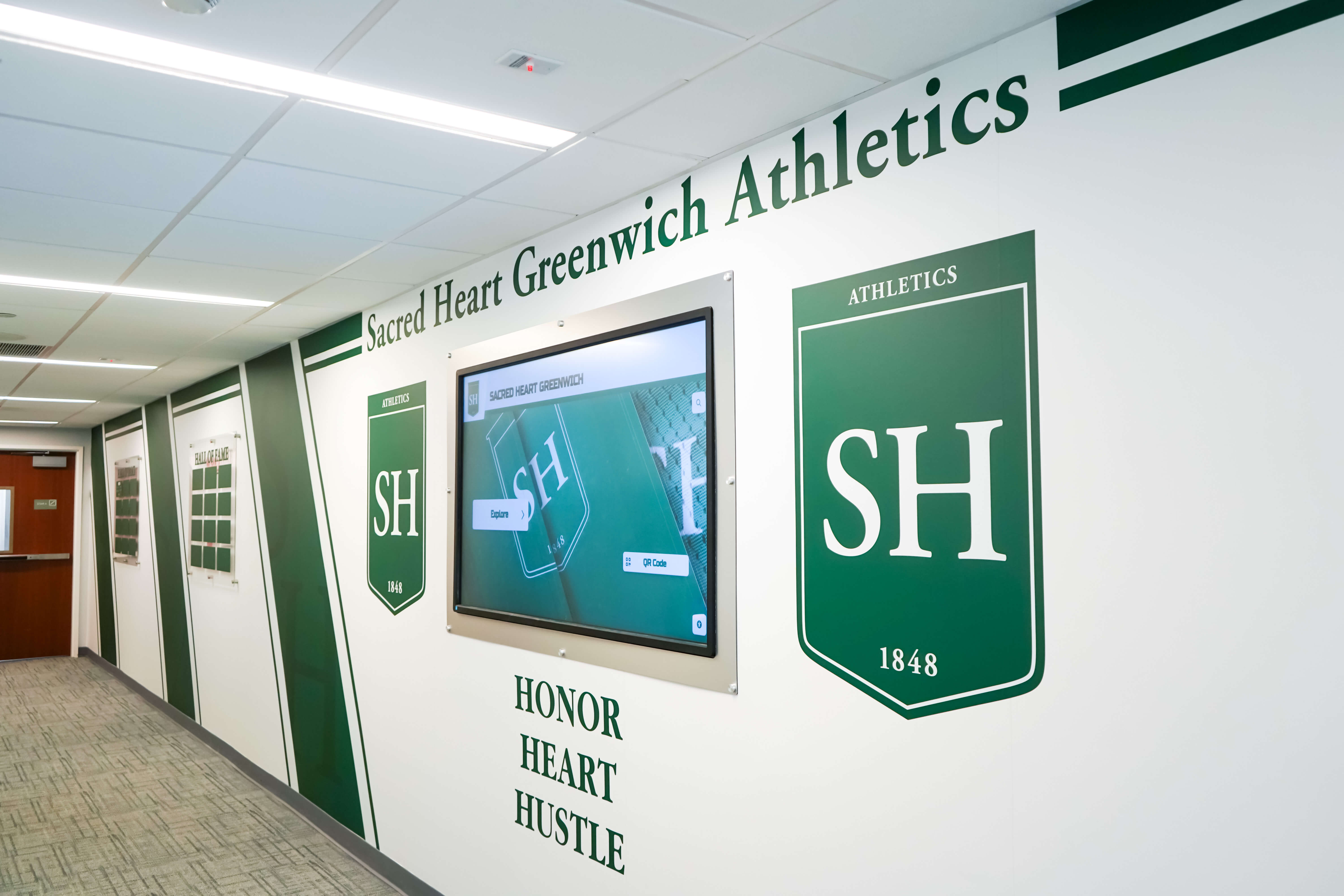
Technical Considerations for Digital Systems
Digital implementations require attention to technical infrastructure and long-term maintenance:
Hardware Selection: Choose commercial-grade displays designed for continuous operation rather than consumer equipment. Consider screen size, resolution, touch sensitivity, and enclosure durability for athletic facility environments where displays will be viewed by diverse audiences.
Software Platform Evaluation: Assess content management ease, design flexibility, multi-sport organization capabilities, multimedia support, search functionality, and vendor stability. Platforms should offer intuitive administration while providing professional visitor experiences that serve all sports equally.
Network Infrastructure: Ensure reliable network connectivity for displays requiring internet access. Plan for both wired and wireless connectivity with adequate bandwidth for video content from multiple sports.
Physical Installation: Professional mounting, appropriate viewing heights, power delivery, and environmental considerations ensure optimal display performance. Budget for professional installation rather than improvised mounting that may not meet institutional standards.
Maintenance Planning: Establish protocols for software updates, hardware cleaning, content backups, and technical troubleshooting. Preventive maintenance extends system life while ensuring consistent operation benefiting all sports equally.
Guidance on hardware selection for digital recognition displays helps athletic departments navigate technical decisions and specify appropriate equipment.
Launch Event Planning
Inaugural induction ceremonies establish program tone while generating excitement and participation:
Event Timing: Coordinate launches with high-visibility occasions—homecoming weekends, major athletic events, or alumni gatherings—maximizing attendance and attention from supporters of all sports.
Inductee Participation: Invite all inaugural inductees from all sports to attend, recognizing them publicly during ceremonies and providing opportunities for interaction with current athletes and fans. Equal prominence for inductees from all sports demonstrates institutional commitment.
Display Unveiling: Create dramatic reveals of new displays through coverings removed during ceremonies, generating excitement while focusing attention on recognition installations that celebrate comprehensive athletic excellence.
Media Coverage: Generate press releases, invite media coverage, and create shareable social media content amplifying program visibility beyond ceremony attendees while highlighting achievements across all sports.
Program Materials: Develop printed programs or digital content documenting inaugural inductees across all sports, providing keepsakes for attendees while creating historical records of launch events.
Maintaining Long-Term Hall of Fame Program Success
Sustained program vitality requires ongoing attention, regular inductions across all sports, content enhancement, and continuous improvement ensuring equitable recognition.
Annual Operations Calendar
Consistent operations maintain program momentum and ensure regular recognition opportunities across all sports:
Fall Planning (August-October): Committee formation, criteria review, budget confirmation, timeline establishment for upcoming cycle, and outreach to coaches from all sports.
Winter Nominations (November-January): Nomination period announcement, outreach to alumni constituencies from all sports, nomination form distribution emphasizing multi-sport representation, and submission collection ensuring coverage across programs.
Spring Selection (February-April): Nominee evaluation across all sports, committee deliberation ensuring equitable consideration, selection voting, inductee notification across sports, and public announcement highlighting multi-sport excellence.
Summer Preparation (May-July): Inductee profile development across all sports, multimedia content collection sport-appropriate to each inductee, display updates, and induction ceremony planning recognizing all sports equally.
Fall Induction (August-October): Ceremony execution recognizing all inductees equally, media coverage highlighting multi-sport achievement, display unveiling, and celebration of comprehensive athletic excellence.

Program Enhancement Strategies
Continuous improvement keeps programs engaging and relevant across years while ensuring all sports benefit:
Criteria Evolution: Periodically review selection criteria ensuring they remain appropriate across all sports, account for sport-specific achievement measures, reflect current program values, and maintain meaningful standards. Criteria should evolve as programs, sports offerings, and competitive contexts change.
Content Enrichment: Systematically enhance existing inductee profiles across all sports with additional photos, updated life information, anniversary retrospectives, or improved multimedia as resources permit. Proportional enhancement across all sports maintains equity.
Technology Upgrades: Plan for periodic technology refreshes—updated displays, improved software platforms, or enhanced capabilities—maintaining modern user experiences that serve all sports effectively.
Engagement Expansion: Develop new engagement opportunities such as inductee speaker series bringing athletes from various sports to campus, mentorship programs connecting inductees with current athletes across all programs, or social media campaigns featuring inductee stories from diverse sports.
Sport-Specific Recognition Cycles: Consider rotating featured content highlighting specific sports during their competitive seasons, creating ongoing engagement while ensuring all programs receive periodic spotlight attention.
Resources on digital wall of fame benefits provide frameworks for evaluating program effectiveness and identifying improvement opportunities across comprehensive athletic programs.
Addressing Unique Challenges in Multi-Sport Recognition
Athletic departments implementing comprehensive recognition across all sports encounter specific challenges requiring thoughtful approaches:
Balancing Visibility Across Revenue and Olympic Sports
Challenge: Revenue sports like football and basketball often dominate recognition due to their higher profiles, more extensive historical documentation, and larger alumni bases, potentially marginalizing achievements in Olympic sports, individual sports, and emerging programs.
Solutions:
- Establish deliberate policies ensuring proportional representation across all sports
- Create sport-specific recognition categories celebrating achievements meaningful within competitive contexts
- Feature rotating spotlight content ensuring all sports receive periodic prominence
- Dedicate equal digital display space to all programs regardless of revenue generation
- Communicate explicitly that the institution values achievement across all athletic programs equally
- Celebrate Olympic sport All-Americans with same prominence as revenue sport honorees
- Recognize conference championships equally whether in volleyball, soccer, swimming, or football
Managing Sport-Specific Achievement Standards
Challenge: Achievement measures differ dramatically across sports—swimming involves time-based records, track includes multiple events, team sports focus on wins and championships, individual sports emphasize tournament placements—making equitable comparison and consistent standards challenging.
Solutions:
- Develop sport-appropriate criteria recognizing that achievement measures vary legitimately
- Consult with coaches and sport-specific experts when establishing criteria
- Allow sport-specific nomination materials that explain achievement significance within competitive contexts
- Educate selection committees about achievement contexts in diverse sports
- Avoid forcing achievements into inappropriate comparison frameworks
- Recognize that All-Conference honors, program records, and championship participation represent excellence regardless of sport
Ensuring Historical Representation Across All Programs
Challenge: Historical documentation quality varies dramatically across sports, with revenue sports typically having extensive records while Olympic sports may have incomplete historical information, potentially resulting in recognition programs that overrepresent well-documented sports.
Solutions:
- Invest in deliberate historical research across all sports
- Interview retired coaches, former athletes, and long-time staff to recover information about underdocumented programs
- Review yearbooks, media guides, and institutional archives for information about all sports
- Accept that some historical eras may have information gaps while ensuring current recognition maintains equity
- Consider “historical cohorts” that recognize era-appropriate achievements across available sports
- Acknowledge documentation limitations openly rather than allowing them to create artificial sport hierarchies

Conclusion: Celebrating Comprehensive Athletic Excellence
College athletics hall of fame programs serve vital purposes in athletic department operations and university communities. They preserve institutional athletic history across all sports that would otherwise fade, honor individuals whose achievements deserve permanent recognition regardless of sport, inspire current student-athletes by connecting them to program traditions spanning all programs, engage alumni communities around shared athletic experiences, and demonstrate institutional commitment to celebrating comprehensive excellence across all athletic endeavors.
The most effective programs balance clear selection standards applicable across all sports with accessible nomination processes, combine traditional recognition gravitas with modern engagement capabilities, and maintain consistent operations that add new inductees regularly while enhancing existing content periodically. Whether athletic departments choose traditional plaques, cutting-edge digital displays, or hybrid approaches combining both, the core principles remain constant: transparent criteria, fair processes across all sports, compelling content, and sustained commitment to program vitality that serves comprehensive athletic programs equitably.
Digital recognition solutions like those from Rocket Alumni Solutions offer particular advantages for athletic programs seeking to honor achievements across all sports equally. Unlimited growth capacity eliminates difficult decisions about which sports receive limited physical display space, rich multimedia storytelling brings achievements from all sports to life emotionally, cost-effective long-term operations reduce recurring expenses across comprehensive programs, and engaging visitor experiences make recognition meaningful to contemporary audiences. The ability to accommodate unlimited inductees from all sports, easily update content, incorporate sport-appropriate multimedia, provide sophisticated search functionality, and extend recognition beyond physical locations makes interactive digital hall of fame systems increasingly popular in collegiate athletic programs committed to comprehensive recognition.
Beyond the immediate purpose of honoring achievement, effective hall of fame programs strengthen connections between past, present, and future—linking legendary athletes from earlier eras and all sports with current teams building new chapters of excellence while inspiring future generations who will carry traditions forward. They demonstrate that athletic programs value comprehensive excellence across all competitive endeavors, inspire student-athletes pursuing diverse sports, and create tangible connections extending across decades of commitment, achievement, and contribution to institutional athletic identity.
Athletic departments ready to launch or enhance comprehensive hall of fame programs can explore additional resources on building school pride through recognition, engaging alumni through digital recognition, and recognition solutions for comprehensive programs that honor athletic legends across all sports while creating sustainable programs benefiting athletic departments, alumni communities, and current student-athletes for generations to come.
College athletic programs build more than winning records—they develop young adults competing across all sports, create lasting memories, forge lifelong bonds, and contribute to institutional identity in ways that transcend individual seasons or specific programs. Hall of fame recognition ensures these contributions across all athletic endeavors receive the lasting acknowledgment they deserve while inspiring continued excellence in collegiate athletics spanning every sport, every athlete, and every program that makes comprehensive college athletics the rich, diverse tradition it represents.
